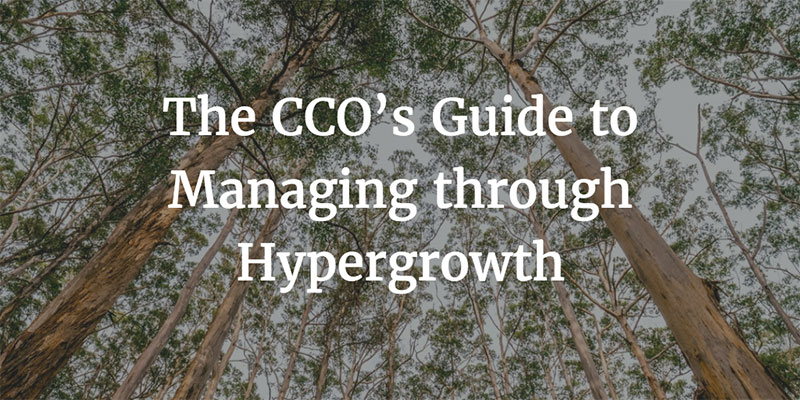Allison Pickens is VP of Customer Success & Business Operations at Gainsight.
I remember when I joined Gainsight in January 2014. We were working in a loft above a bar, which shared our address on Castro Street. When clients came to see us, they would sometimes go to the bar, only to be directed by the bartender to walk around the corner and up the narrow staircase to find our office.
At the time, we had just raised our Series B round, on a dream that a “Customer Success movement” might be in the making and that we could help. We’ve grown a fair bit since then, but—to be totally honest—this journey hasn’t exactly been a cake walk. Hypergrowth is a mountain that only gets steeper as you climb. And we’re probably 5% of the way up. We’ve made it to this point because, above all, we love the climb so much that we keep putting one foot in front of the other.
In past blog entries, I’ve shared many of the initiatives that have enabled our Customer Success organization to evolve to this point. Today I want to step back and reflect on a broader philosophy for managing through hypergrowth in a CS organization. Here are the 7 principles that I try to follow.
1. Conquer uncertainty.
Through the haze of retrospection, you might look at our journey and say it was inevitable, predictable. Anyone at Gainsight can tell you that wasn’t true. And I can’t predict with absolute precision what next year will be like. But it’s my job to instill confidence in my team and our company. So I’m always thinking about how to conquer uncertainty and make the business as predictable as possible, while preserving room for creativity.
One way I try to foster a predictable environment is by sharing with my team the metrics that guide our investments as we scale. Those include our Cost to ARR ratio, utilization, and others. Folks want to know when we can hire the next person, to relieve the seemingly ever-increasing workload.
The team also wants to know how we’re doing. We’ve found it helpful to schedule a quarterly All Hands to review my portion of our board deck and allow plenty of time for questions. And team leaders publish weekly updates to Chatter.
Yet, as hard as we try to bury uncertainty, we know that the unexpected will resurface. At the very least, we can be certain that this is an adventure, so let’s make it a fun one. That’s where karaoke comes in.
2. Create a vision…and talk about it all the time.
My parents, brother, and I used to take long road trips from Philadelphia to the Outer Banks of North Carolina. During those 8 hours, inevitably someone would get carsick. My parents would always say, “Focus on a steady point on the horizon.”
Through the vicissitudes of hypergrowth, teams want to know: what’s that constant mission that I can fixate on?
In our case, our mission in Customer Success at Gainsight is to “Carry the Torch.” Picture the person at the Olympics opening ceremony who literally carries the torch and leads a procession. By analogy, it’s an existential imperative at Gainsight that our Customer Success team leads the industry. (I shared this with a customer recently, and he said, “That’s a better way of saying that you eat your own dog food.”)
Carrying the Torch means that our team strives to serve as an incubator for best practices—to explore, vet, discard, pilot, refine, and then share ideas with the industry. We’re not perfect, but we get up every morning for our customers.
3. Clarify what counts as success.
One of my responsibilities as an executive is to communicate the standards set by the market, to clarify what counts as success. Every time I meet with a client or present to the board, I get feedback from the market. I aim to be transparent with the team about what I’m hearing, so that we can strive to achieve those standards. There’s an external definition of success.
At the same time, Customer Success is a relatively new field, which means we can’t just react to what the market is telling us. I find the best CS teams educate the market on how to evaluate them. Our team has identified metrics that measure our success and broadened awareness of them across our leadership team and board.
Those metrics help us prioritize efforts—which is critical for us, given that we literally could be working on 100 initiatives right now if we had the resources. (Our CS Operations’ team backlog is probably at least this long.) If an initiative isn’t going to drive one of our key metrics in a meaningful way, let’s scrap it.
4. Execution matters.
As the mountain gets steeper, a false step causes you to stumble farther. Execution matters in this stage. That’s why we are constantly building new processes, to prevent ourselves from making the same mistake twice.
That said, perfectionism can be crippling. It can prevent us from living in the moment, from tapping our creative pipes, from being emotionally present for others. I don’t want a team of perfectionists. I do hope for us that we strive for continuous improvement, that we learn from our mistakes, and that we’re never satisfied.
Perfectionism is a mistake for another reason. It assumes a fixed standard, a box that we can check. The reality is that as we grow, the hurdles get higher. So I say: Let’s keep attempting to surmount those hurdles, with the knowledge that we’ll never be perfect hurdle-jumpers but can always try harder.
5. Exhale positivity.
One of my most deeply held beliefs in life is that when you exhale positivity, it will circle back to you in the breeze. I believe we can do anything that we believe we can.
I share with my team: Every single time we have set our minds to making something happen, we make it happen. It’s okay that we haven’t done something before. I believe we can do it.
Our CEO Nick Mehta once said, being in a startup is like digging for oil. And we can debate about exactly where in this oil field we will strike a reservoir, but we can’t debate this: Oil does exist somewhere.
There is always a path to success. I want to hear a ton of ideas from my team on all the possible paths, and we should discuss these vigorously. But we should agree that we will always assume a viable path exists.
6. Learn constantly.
Every Monday I come to work and realize that our company has changed from last week.
That means that every week we need to learn something new. In fact, it’s our obligation to evolve our skill set to meet the changing demands of our market. And managers need to coach our team members to help them develop in the right direction. If each team member is growing at least as fast as the company, we’re doing great.
Every quarter, I create a personal development plan for myself. This quarter I shared that plan with my team, because I wanted to show that all team members—even (and maybe especially) executives—need to continuously invest in improving themselves.
Our company recently introduced a new value, “Shoshin,” which is a concept in Zen Buddhism that means “beginner’s mind.” I love this new value because it reminds us of the humility required to constantly adapt to the demands of hypergrowth.
7. Express gratitude.
All day long, my team talks about what we can do better. We are our own toughest critic.
It’s equally important to recognize what has gone well. We are extremely lucky—we need to count our blessings. We’re grateful for the support from the Customer Success industry. We’re indebted to the other teams at Gainsight. We’re fortunate to have some money in the bank.
I’m also grateful that my team has fought for every inch our company has grown. They’ve battled discouragement in trying times, hunkered down in late nights, found creative sparks in darkness, and supported each other in rebounds. They’ve earned it. It’s my job to celebrate them.
Thank you, team, for a wonderfully memorable 2016 🙂 Cheers to the new year to come.

